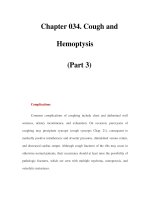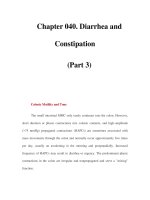Endocrine and Metabolic Emergencies - part 3 pps
Bạn đang xem bản rút gọn của tài liệu. Xem và tải ngay bản đầy đủ của tài liệu tại đây (326.66 KB, 3 trang )
develops between 6 weeks to 6 months postpartum with an incidence of
about 5% to 10% of all women [12]. This is followed by a hypothyroid state
with a return to baseline after about 1 year, although some women may
develop permanent hypothyroidism. There is usually a small, nontender
goiter, and symptoms are usually mild, the result of either the hyperthyroid
or hypothyroid state. There is approximately a 70% chance of recurrence in
subsequent pregnancies in those who had postpartum thyroiditis with their
first pregnancy [12].
Sporadic thyroiditis is a condition similar in clinical course to postpartum
thyroiditis, but it is not associated with pregnancy [11]. Up to 20% of these
patients eventually develop lasting hypothyroidism.
Suppurative thyroiditis is an infection of the thyroid gland typically
caused by a bacterial infection, and less commonly by fungal, mycobacte-
rial, or parasitic infections [11]. Although rare, it is more common in those
with pre-existing thyroid disease and in immunocompromised patients.
Clinical features include a painful thyroid gland (anterior neck pain with
erythema), fever, dysphagia, and dysphonia.
Amiodarone-induced thyroiditis is associated with either symptomatic or
asymptomatic hyperthyroidism. It occurs in about 10% of patients in
iodine-deficient areas, and less commonly in iodine-replete areas [7]. The
mechanism of thyroid dysfunction from the use of amiodarone is caused
either by the release of the iodine from the drug itself or by the development
of destructive thyroiditis. Individuals with underlying autoimmunity are at
increased risk for developing hyperthyroidism if they are taking amiodar-
one. Nodular and multinodular goiters, which are more common in the
elderly, are a predisposing factor for amiodarone-induced thyroiditis [7].
Clinical features
Thyroid hormone affects nearly every organ system in the body. Patients
with elevated thyroid hormone present in a hypermetabolic state with signs
of increased b-adrenergic activity. Severity of the symptoms and signs of
thyrotoxicosis are related to the duration of the disease, the magnitude of
thyroid hormone excess, and age [13]. Although the diagnosis is frequently
straightforward in patients with overt features of hyperthyroidism, a high
degree of clinical suspicion has to be exercised in those with subtle clinical
features of hyperthyroidism.
History
Constitutional
Many nonspecific complaints are common, particularly when hyperthy-
roidism is not yet advanced or when it occurs in the elderly. Complaints
such as fatigue, nervousness, or anxiety can lead one to consider a
672 MCKEOWN et al
Recognition and Management of
Adrenal Emergencies
Susan P. Torrey, MD
a,b
a
Tufts University School of Medicine, 136 Harrison Avenue Boston, MA 02111, USA
b
Department of Emergency Medicine, Baystate Medical Center,
759 Chestnut Street, Springfield, MA 01199, USA
Case 1. A 52-year-old woman presents to the emergency department
(ED) with the chief complaint of palpitations, sweating, and chest tightness.
This has been a recurrent problem for the patient over the prior 6 months.
She has been treated with benzodiazepines by her primary care provider.
Although the sympto ms are improving on presentation to the ED, she says
she felt like she was going to die. PMH is otherwise negative. She does not
smoke and denies drug or regular alcohol use. Exam in the ED includes:
vital signs: 188/104, 108, 20, 98.8
F, oxygen saturation 98%; lungs: clear
without wheeze or rales; cardiac: regular without murmur; abdomen: soft,
nontender; neurologic: nonfocal exam. Is this simply another presentation
of an anxiety attack in the ED?
Pheochromocytomas
Pheochromocytomas are notorious but rare catecholamine-secreting
tumors of neuroectodermal origin. There are several clinical issues of
importance to emergency physicians, ranging from the potential for
presentation as a hypertensive emergen cy to the recognition of more subtle
symptoms masquerading as yet another anxiety attack. Although pheo-
chromocytoma will be diagnosed or treated infrequently in the emergency
ED, it is an important entity to consider in the differential diagnosis of
several presentations .
Pheochromocytomas can occur anywhere along the sympathetic chain,
although 85% to 90% are discovered within the adrenal gland. In adults, at
least 10% are extra-adrenal; 10% are bilateral, and 10% are malignant, with
E-mail address:
0733-8627/05/$ - see front matter Ó 2005 Elsevier Inc. All rights reserved.
doi:10.1016/j.emc.2005.03.003 emed.theclinics.com
Emerg Med Clin N Am 23 (2005) 687–702
Bone and Mineral Metabolism
John Sarko, MD
Department of Emergency Medicine, Maricopa Medical Center,
2601 E. Roosevelt Street, Phoenix, AZ 85008, USA
In addition to providing strength, support for the body, and serving as
the attachment for muscles to allow movement to occur, bone is extremely
active on a metabolic level and is important in the regulation of several
endocrine functions. It is the major source of calcium; it buffers against
acidosis, and can adsorb toxins and heavy metals. Calcium, phosphate, and
magnesium are minerals vital to the function of all cells. They are tightly
regulated by several hormones, and disorders in their metabolism are
common. In this article, bone structure and function, and mineral
metabolism are reviewed. Conditions leading to bone loss are discussed,
as diseases increasing bone density are rare and less likely to be encountered
by emergency physicians.
Bone and bone metabolism
Anatomy of bone
Bone comprises approximately 14% of the adult weight. Two types of
bone exist: cortical (compact) and cancellous (spongy) [1]. Compact bone
comprises 85% of the skeleton, is strong, solid, and very organized. Its basic
structural unit is the Haversian system (osteon), a cylindrical entity that runs
along the long axis of the bone (see Fig. 1). It is comprised of concentric
rings of matrix called lamellae, which contain small holes called lacunae
with an osteocyte in each. The center of the Haversian system is an opening
called the Haversian canal, which contains blood vessels and nerves.
Haversian canals and lacunae are connected to each other by canaliculi that
are oriented parallel to the horizontal axis of the bone.
Cancellous (spongy) bone makes up 15% of the skeleton, and most bones
contain at least some of each type. The vertebrae are predominately
E-mail address:
0733-8627/05/$ - see front matter Ó 2005 Elsevier Inc. All rights reserved.
doi:10.1016/j.emc.2005.03.017 emed.theclinics.com
Emerg Med Clin N Am 23 (2005) 703–721









